Polymer Capacitor Films with Nanoscale Coatings for Dielectric Energy Storage: A Review
Abstract
:1. Introduction
| Polymer | Condition | K | Eb (MV m−1) | Ud (J cm−3) | η (%) | Ref. |
|---|---|---|---|---|---|---|
| BOPP | RT | 2.3 | 694 | 5.9 | 91 | [66] |
| 120 °C | 2.3 | 428 | 2.0 | 85 | ||
| Kapton® PI | 150 °C | 3.1 | / | 0.5 | 15 | [67] |
| 200 °C | 3 | / | 0.2 | 35 | ||
| Ultem® PEI | RT | 3.2 | 501 | 5.5 | 85 | [43] |
| 150 °C | 3.2 | 470 | 3.1 | 75 | [56] | |
| 200 °C | 3.2 | 440 | 2.5 | 65 |
2. Fundamentals of Energy Storage in Polymer Dielectrics
2.1. Dielectric Constant and Dielectric Loss
2.2. Dielectric Breakdown
2.3. Charge Injection and Migration
3. Effect of Coating Methods and Materials on Energy Storage Performance
3.1. Chemical Methods for Coating
3.2. Physical Methods for Coating
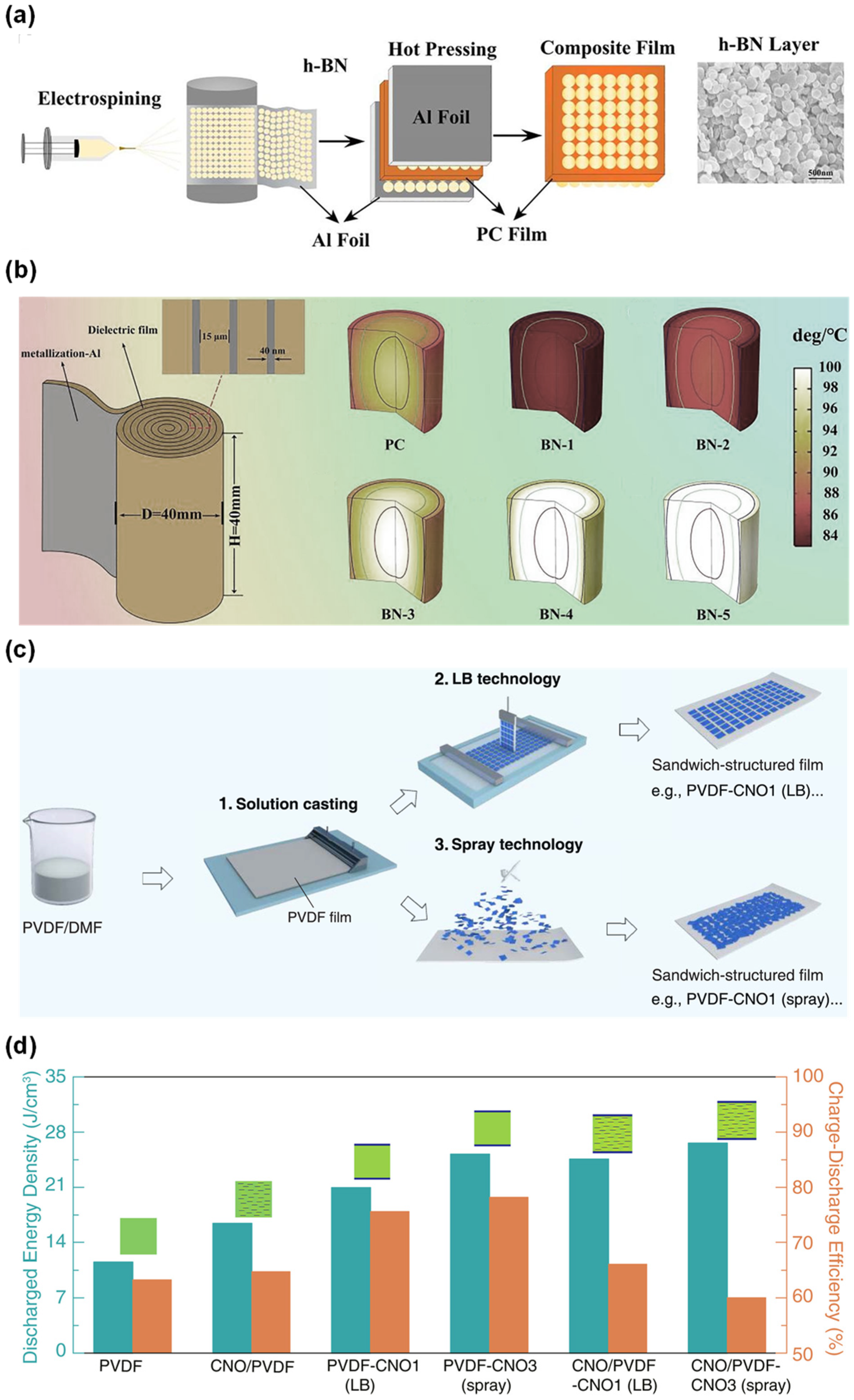
3.3. Molecular-Level Surface Modification
3.4. Polymeric Coatings and Multilayered Polymeric Films
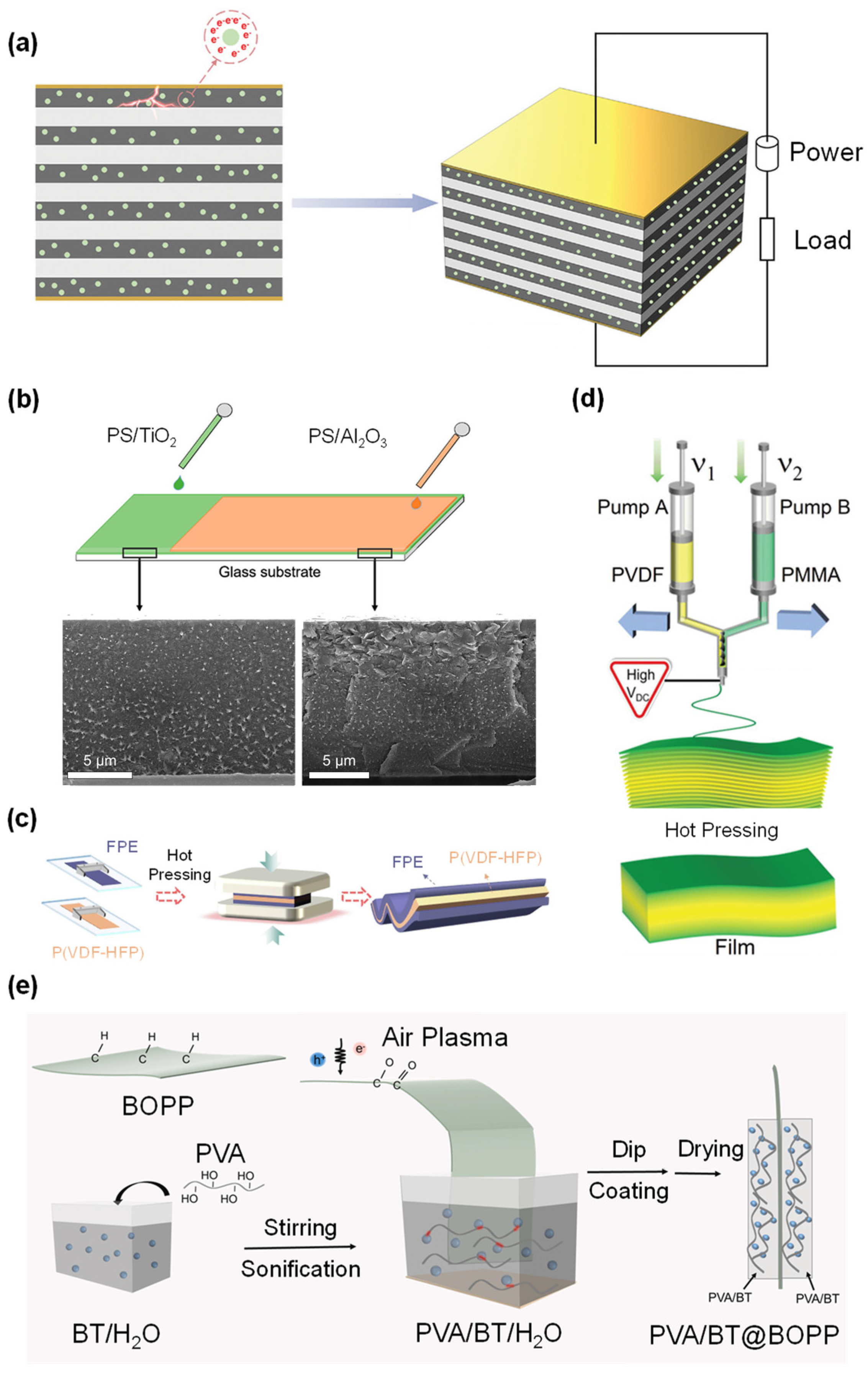
4. Summary and Perspectives
Author Contributions
Funding
Institutional Review Board Statement
Informed Consent Statement
Data Availability Statement
Acknowledgments
Conflicts of Interest
References
- Deka, B.; Cho, K.-H. BiFeO3-Based Relaxor Ferroelectrics for Energy Storage: Progress and Prospects. Materials 2021, 14, 7188. [Google Scholar] [CrossRef] [PubMed]
- Liu, X.; Yao, Y.; Wang, X.; Zhao, L.; San, X. Energy Storage Performance of (Na0.5Bi0.5)TiO3 Relaxor Ferroelectric Film. Coatings 2024, 14, 801. [Google Scholar] [CrossRef]
- Yang, Z.; Yue, D.; Yao, Y.; Li, J.; Chi, Q.; Chen, Q.; Min, D.; Feng, Y. Energy Storage Application of All-Organic Polymer Dielectrics: A Review. Polymers 2022, 14, 1160. [Google Scholar] [CrossRef] [PubMed]
- Bonardd, S.; Moreno-Serna, V.; Kortaberria, G.; Díaz Díaz, D.; Leiva, A.; Saldías, C. Dipolar Glass Polymers Containing Polarizable Groups as Dielectric Materials for Energy Storage Applications. A Minireview. Polymers 2019, 11, 317. [Google Scholar] [CrossRef]
- Phillips, J. Toward an Improved Understanding of the Role of Dielectrics in Capacitors. Materials 2018, 11, 1519. [Google Scholar] [CrossRef]
- Gnonhoue, O.G.; Velazquez-Salazar, A.; David, É.; Preda, I. Review of Technologies and Materials Used in High-Voltage Film Capacitors. Polymers 2021, 13, 766. [Google Scholar] [CrossRef]
- Tawade, B.V.; Singh, M.; Apata, I.E.; Veerasamy, J.; Pradhan, N.; Karim, A.; Douglas, J.F.; Raghavan, D. Polymer-grafted nanoparticles with variable grafting densities for high energy density polymeric nanocomposite dielectric capacitors. J. Am. Chem. Soc. Au 2023, 3, 1365. [Google Scholar] [CrossRef]
- Meng, Z.; Zhang, T.; Zhang, C.; Shang, Y.; Lei, Q.; Chi, Q. Advances in polymer dielectrics with high energy storage performance by designing electric charge trap structures. Adv. Mater. 2024, 2310272. [Google Scholar] [CrossRef] [PubMed]
- Zha, J.-W.; Xiao, M.; Wan, B.; Wang, X.; Dang, Z.-M.; Chen, G. Polymer dielectrics for high-temperature energy storage: Constructing carrier traps. Prog. Mater. Sci. 2023, 140, 101208. [Google Scholar] [CrossRef]
- Wu, X.; Karlin, A.; Beilin, V.; Shter, G.E.; Grader, G.S.; Ivry, Y.; Lin, S.; Tan, D.Q. Chain-like semiconductive fillers for dielectric enhancement and loss reduction of polymer composites. Adv. Mater. 2024, 36, 2401597. [Google Scholar] [CrossRef]
- Luo, H.; Zhou, X.; Ellingford, C.; Zhang, Y.; Chen, S.; Zhou, K.; Zhang, D.; Bowen, C.R.; Wan, C. Interface design for high energy density polymer nanocomposites. Chem. Soc. Rev. 2019, 48, 4424. [Google Scholar] [CrossRef] [PubMed]
- Pattipaka, S.; Lim, Y.; Son, Y.H.; Bae, Y.M.; Peddigari, M.; Hwang, G.-T. Ceramic-Based Dielectric Materials for Energy Storage Capacitor Applications. Materials 2024, 17, 2277. [Google Scholar] [CrossRef] [PubMed]
- Zhang, M.; Lan, S.; Yang, B.B.; Pan, H.; Liu, Y.Q.; Zhang, Q.H.; Qi, J.L.; Chen, D.; Su, H.; Yi, D.; et al. Ultrahigh energy storage in high-entropy ceramic capacitors with polymorphic relaxor phase. Science 2024, 384, 185. [Google Scholar] [CrossRef]
- Yang, B.; Zhang, Q.; Huang, H.; Pan, H.; Zhu, W.; Meng, F.; Lan, S.; Liu, Y.; Wei, B.; Liu, Y.; et al. Engineering relaxors by entropy for high energy storage performance. Nat. Energy 2023, 8, 956. [Google Scholar] [CrossRef]
- Yang, B.; Zhang, Y.; Pan, H.; Si, W.; Zhang, Q.; Shen, Z.; Yu, Y.; Lan, S.; Meng, F.; Liu, Y.; et al. High-entropy enhanced capacitive energy storage. Nat. Mater. 2022, 21, 1074. [Google Scholar] [CrossRef] [PubMed]
- Pan, H.; Lan, S.; Xu, S.; Zhang, Q.; Yao, H.; Liu, Y.; Meng, F.; Guo, E.-J.; Gu, L.; Yi, D.; et al. Ultrahigh energy storage in superparaelectric relaxor ferroelectrics. Science 2021, 374, 100. [Google Scholar]
- Wang, J. High-Performance Dielectric Ceramic for Energy Storage Capacitors. Coatings 2022, 12, 889. [Google Scholar] [CrossRef]
- Wang, T.-Y.; Mao, J.; Zhang, B.; Zhang, G.-X.; Dang, Z.-M. Polymeric insulating materials characteristics for high-voltage applications. Nat. Rev. Electr. Eng. 2024, 1, 516. [Google Scholar] [CrossRef]
- Zhang, T.; Sun, H.; Yin, C.; Jung, Y.H.; Min, S.; Zhang, Y.; Zhang, C.; Chen, Q.; Lee, K.J.; Chi, Q. Recent progress in polymer dielectric energy storage: From film fabrication and modification to capacitor performance and application. Prog. Mater. Sci. 2023, 140, 101207. [Google Scholar] [CrossRef]
- Chen, J.; Pei, Z.; Chai, B.; Jiang, P.; Ma, L.; Zhu, L.; Huang, X. Engineering the dielectric constants of polymers: From molecular to mesoscopic scales. Adv. Mater. 2024, 2308670. [Google Scholar] [CrossRef]
- Zhang, Q.; Chen, X.; Zhang, B.; Zhang, T.; Lu, W.; Chen, Z.; Liu, Z.; Kim, S.H.; Donovan, B.; Warzoha, R.J.; et al. High-temperature polymers with record-high breakdown strength enabled by rationally designed chain-packing behavior in blends. Matter 2021, 4, 2448. [Google Scholar] [CrossRef]
- Tan, D.Q. Review of polymer-based nanodielectric exploration and film scale-up for advanced capacitors. Adv. Funct. Mater. 2020, 30, 1808567. [Google Scholar] [CrossRef]
- Yang, M.; Guo, M.; Xu, E.; Ren, W.; Wang, D.; Li, S.; Zhang, S.; Nan, C.-W.; Shen, Y. Polymer nanocomposite dielectrics for capacitive energy storage. Nat. Nanotechnol. 2024, 19, 588. [Google Scholar] [CrossRef]
- Feng, Q.-K.; Zhong, S.-L.; Pei, J.-Y.; Zhao, Y.; Zhang, D.-L.; Liu, D.-F.; Zhang, Y.-X.; Dang, Z.-M. Recent progress and future prospects on all-organic polymer dielectrics for energy storage capacitors. Chem. Rev. 2022, 122, 3820. [Google Scholar] [CrossRef]
- Pei, J.-Y.; Yin, L.-J.; Zhong, S.-L.; Dang, Z.-M. Suppressing the loss of polymer-based dielectrics for high power energy storage. Adv. Mater. 2023, 35, 2203623. [Google Scholar] [CrossRef]
- Zhang, X.; Zhang, L.; Li, M.; Chen, W.; Chen, J.; Liu, Y.J.; Wang, Y. Research Advances in Hierarchically Structured PVDF-Based All-Organic Composites for High-Energy Density Capacitors. Membranes 2022, 12, 274. [Google Scholar] [CrossRef]
- Pan, Z.; Mao, M.; Zhang, B.; Li, Z.; Song, K.; Li, H.-F.; Mao, Z.; Wang, D. Excellent Energy Storage Performance in Epoxy Resin Dielectric Polymer Films by a Facile Hot−Pressing Method. Polymers 2023, 15, 2315. [Google Scholar] [CrossRef]
- Xiao, M.; Zhang, M.; Liu, H.; Du, B.; Qin, Y. Dielectric Property and Breakdown Strength Performance of Long-Chain Branched Polypropylene for Metallized Film Capacitors. Materials 2022, 15, 3071. [Google Scholar] [CrossRef] [PubMed]
- Chen, C.; Shen, L.; Liu, G.; Cui, Y.; Yan, S. Improved Energy Storage Performance of Composite Films Based on Linear/Ferroelectric Polarization Characteristics. Polymers 2024, 16, 1058. [Google Scholar] [CrossRef]
- Liu, X.-J.; Zheng, M.-S.; Chen, G.; Dang, Z.-M.; Zha, J.-W. High-temperature polyimide dielectric materials for energy storage: Theory, design, preparation and properties. Energy Environ. Sci. 2022, 15, 56. [Google Scholar] [CrossRef]
- Wu, C.; Deshmukh, A.A.; Chen, L.; Ramprasad, R.; Sotzing, G.A.; Cao, Y. Rational design of all-organic flexible high-temperature polymer dielectrics. Matter 2022, 5, 2615. [Google Scholar] [CrossRef]
- Li, Q.; Yao, F.Z.; Liu, Y.; Zhang, G.; Wang, H.; Wang, Q. High-temperature dielectric materials for electrical energy storage. Ann. Rev. Mater. Res. 2018, 48, 219. [Google Scholar] [CrossRef]
- Li, H.; Chang, B.S.; Kim, H.; Xie, Z.; Lainé, A.; Ma, L.; Xu, T.; Yang, C.; Kwon, J.; Shelton, S.W.; et al. High-Performing Polysulfate Dielectrics for Electrostatic Energy Storage under Harsh Conditions. Joule 2023, 7, 95–111. [Google Scholar] [CrossRef] [PubMed]
- Pan, Z.; Li, L.; Wang, L.; Luo, G.; Xu, X.; Jin, F.; Dong, J.; Niu, Y.; Sun, L.; Guo, C.; et al. Tailoring poly(styrene-co-maleic anhydride) networks for all-polymer dielectrics exhibiting ultrahigh energy density and charge–discharge efficiency at elevated temperatures. Adv. Mater. 2023, 35, 2207580. [Google Scholar] [CrossRef] [PubMed]
- Wu, C.; Deshmukh, A.A.; Yassin, O.; Cao, Y. Flexible cyclic-olefin with enhanced dipolar relaxation for harsh condition electrification. Proc. Natl. Acad. Sci. USA 2021, 118, e2115367118. [Google Scholar] [CrossRef] [PubMed]
- Chen, J.; Pei, Z.; Liu, Y.; Shi, K.; Zhu, Y.; Zhang, Z.; Jiang, P.; Huang, X. Aromatic-free polymers based all-organic dielectrics with breakdown self-healing for high-temperature capacitive energy storage. Adv. Mater. 2023, 35, 2306562. [Google Scholar] [CrossRef]
- Chen, J.; Zhou, Y.; Huang, X.; Yu, C.; Han, D.; Wang, A.; Zhu, Y.; Shi, K.; Kang, Q.; Li, P.; et al. Ladderphane copolymers for high-temperature capacitive energy storage. Nature 2023, 615, 62. [Google Scholar] [CrossRef]
- Wang, R.; Zhu, Y.; Fu, J.; Yang, M.; Ran, Z.; Li, J.; Li, J.; Li, M.; Hu, J.; He, J.; et al. Designing tailored combinations of structural units in polymer dielectrics for high-temperature capacitive energy storage. Nat. Commun. 2022, 14, 2406. [Google Scholar] [CrossRef]
- Xu, W.; Zhou, C.; Ji, W.; Zhang, Y.; Jiang, Z.; Bertram, F.; Shang, Y.; Zhang, H.; Shen, C. Anisotropic semicrystalline homopolymer dielectrics for high-temperature capacitive energy storage. Angew. Chem. Int. Ed. 2024, 63, e202319766. [Google Scholar] [CrossRef]
- Ran, Z.; Wang, R.; Fu, J.; Yang, M.; Li, M.; Hu, J.; He, J.; Li, Q. Spiral-structured dielectric polymers exhibiting ultrahigh energy density and charge–discharge efficiency at high temperatures. Adv. Mater. 2023, 35, 2303849. [Google Scholar] [CrossRef]
- Shukla, S.; Wu, C.; Mishra, A.; Pan, J.; Charnay, A.P.; Khomane, A.; Deshmukh, A.; Zhou, J.; Mukherjee, M.; Gurnani, R.; et al. Pendant group functionalization of cyclic olefin for high temperature and high-density energy storage. Adv. Mater. 2024, 36, 2402133. [Google Scholar] [CrossRef] [PubMed]
- Deshmukh, A.; Wu, C.; Yassin, O.; Mishra, A.; Chen, L.; Alamri, A.; Li, Z.; Zhou, J.; Mutlu, Z.; Sotzing, M.; et al. Flexible polyolefin dielectric by strategic design of organic modules for harsh condition electrification. Energy Environ. Sci. 2022, 15, 1307. [Google Scholar] [CrossRef]
- Ren, L.; Li, H.; Xie, Z.; Ai, D.; Zhou, Y.; Liu, Y.; Zhang, S.; Yang, L.; Zhao, X.; Peng, Z.; et al. High-Temperature High-Energy-Density Dielectric Polymer Nanocomposites Utilizing Inorganic Core–Shell Nanostructured Nanofillers. Adv. Energy Mater. 2021, 11, 2101297. [Google Scholar] [CrossRef]
- Zhu, C.; Yin, J.; Feng, Y.; Li, J.; Li, Y.; Zhao, H.; Yue, D.; Liu, X. Enhanced Energy Storage Performance of PVDF-Based Composites Using BN@PDA Sheets and Titania Nanosheets. Materials 2022, 15, 4370. [Google Scholar] [CrossRef]
- Li, Y.; Zhou, Y.; Cheng, S.; Hu, J.; He, J.; Li, Q. Polymer Nanocomposites with High Energy Density Utilizing Oriented Nanosheets and High-Dielectric-Constant Nanoparticles. Materials 2021, 14, 4780. [Google Scholar] [CrossRef]
- Xie, Z.; Le, K.; Li, H.; Pang, X.; Xu, T.; Altoé, V.; Kilvansky, L.M.; Wang, Y.; Huang, Z.; Shelton, S.W.; et al. Interfacial Engineering using Covalent Organic Frameworks in Polymer Composites for High-Temperature Electrostatic Energy Storage. Adv. Funct. Mater. 2024, 34, 2314910. [Google Scholar] [CrossRef]
- Li, H.; Xie, Z.; Yang, C.; Kwon, J.; Lainé, A.; Dun, C.; Galoustian, A.V.; Li, X.; Liu, P.; Urban, J.J.; et al. Flexible All-Organic Nanocomposite Films Interlayered with In Situ Synthesized Covalent Organic Frameworks for Electrostatic Energy Storage. Nano Energy 2023, 113, 108544. [Google Scholar] [CrossRef]
- Ren, L.; Yang, L.; Zhang, S.; Li, H.; Zhou, Y.; Ai, D.; Xie, Z.; Zhao, X.; Peng, Z.; Liao, R.; et al. Largely Enhanced Dielectric Properties of Polymer Composites with HfO2 Nanoparticles for High-Temperature Film Capacitors. Compos. Sci. Technol. 2021, 201, 108528. [Google Scholar] [CrossRef]
- Zheng, W.; Ren, L.; Zhao, X.; Li, H.; Xie, Z.; Li, Y.; Wang, C.; Yu, L.; Yang, L.; Liao, R. Tuning Interfacial Relaxations in P(VDF-HFP) with Al2O3@ZrO2 Core-Shell Nanofillers for Enhanced Dielectric and Energy Storage Performance. Compos. Sci. Technol. 2022, 222, 109379. [Google Scholar] [CrossRef]
- Ai, D.; Wu, C.; Han, Y.; Chang, Y.; Xie, Z.; Yu, H.; Ma, Y.; Cheng, Y.; Wu, G. Polymer Nanocomposites with Concurrently Enhanced Dielectric Constant and Breakdown Strength at High Temperature Enabled by Rationally Designed Core-Shell Structured Nanofillers. J. Mater. Sci. Technol. 2025, 210, 170. [Google Scholar] [CrossRef]
- Ai, D.; Han, Y.; Xie, Z.; Pang, X.; Chang, Y.; Li, H.; Wu, C.; Cheng, Y.; Wu, G. High Temperature Polyimide Nanocomposites Containing Two-Dimensional Nanofillers for Improved Thermal Stability and Capacitive Energy Storage Performance. Nano Res. 2024, 17, 7746. [Google Scholar] [CrossRef]
- Pu, Z.; Zheng, X.; Tian, Y.; Hu, L.; Zhong, J. Flexible Ultrahigh-Temperature Polymer-Based Dielectrics with High Permittivity for Film Capacitor Applications. Polymers 2017, 9, 596. [Google Scholar] [CrossRef] [PubMed]
- Chen, J.; Zhang, X.; Yang, X.; Li, C.; Wang, Y.; Chen, W. High Breakdown Strength and Energy Storage Density in Aligned SrTiO3@ SiO2 Core–Shell Platelets Incorporated Polymer Composites. Membranes 2021, 11, 756. [Google Scholar] [CrossRef]
- Wang, J.; Xie, Y.; Liu, J.; Zhang, Z.; Zhuang, Q.; Kong, J. Improved Energy Storage Performance of Linear Dielectric Polymer Nanodielectrics with Polydopamine coated BN Nanosheets. Polymers 2018, 10, 1349. [Google Scholar] [CrossRef]
- Yang, M.; Wang, S.; Fu, J.; Zhu, Y.; Liang, J.; Cheng, S.; Hu, S.; Hu, J.; He, J.; Li, Q. Quantum size effect to induce colossal high-temperature energy storage density and efficiency in polymer/inorganic cluster composites. Adv. Mater. 2023, 35, 2301936. [Google Scholar] [CrossRef]
- Yang, M.; Li, H.; Wang, J.; Shi, W.; Zhang, Q.; Xing, H.; Ren, W.; Sun, B.; Guo, M.; Xu, E.; et al. Roll-to-roll fabricated polymer composites filled with subnanosheets exhibiting high energy density and cyclic stability at 200 °C. Nat. Energy 2024, 9, 143. [Google Scholar] [CrossRef]
- Yuan, C.; Zhou, Y.; Zhu, J.; Liang, J.; Wang, S.; Peng, S.; Li, Y.; Cheng, S.; Yang, M.; Hu, J.; et al. Polymer/molecular semiconductor all-organic composites for high-temperature dielectric energy storage. Nat. Commun. 2020, 11, 3919. [Google Scholar] [CrossRef] [PubMed]
- Yang, M.; Zhou, L.; Li, X.; Ren, W.; Shen, Y. Polyimides physically crosslinked by aromatic molecules exhibit ultrahigh energy density at 200 °C. Adv. Mater. 2023, 35, 2302392. [Google Scholar] [CrossRef] [PubMed]
- Ren, W.; Yang, M.; Zhou, L.; Fan, Y.; He, S.; Pan, J.; Tang, T.; Xiao, Y.; Nan, C.-W.; Shen, Y. Scalable ultrathin all-organic polymer dielectric films for high-temperature capacitive energy storage. Adv. Mater. 2022, 34, 2207421. [Google Scholar] [CrossRef]
- Dong, J.; Li, L.; Qiu, P.; Pan, Y.; Niu, Y.; Sun, L.; Pan, Z.; Liu, Y.; Tan, L.; Xu, X.; et al. Scalable polyimide-organosilicate hybrid films for high-temperature capacitive energy storage. Adv. Mater. 2023, 35, 2211487. [Google Scholar] [CrossRef]
- Liu, X.; Chen, D.; Li, J.; Zhong, S.-L.; Feng, Y.; Yue, D.; Sheng, D.; Chen, H.; Hao, X.; Dang, Z.-M. Atomic-level matching metal-ion organic hybrid interface to enhance energy storage of polymer-based composite dielectrics. Adv. Mater. 2024, 36, 2402239. [Google Scholar] [CrossRef] [PubMed]
- Li, H.; Vargo, E.; Xie, Z.; Ma, L.; Pieters, P.F.; Shelton, S.W.; Alivisatos, A.P.; Xu, T.; Liu, Y. Multilaminate Energy Storage Films from Entropy-Driven Self-Assembled Supramolecular Nanocomposites. Adv. Mater. 2024, 36, 2401954. [Google Scholar] [CrossRef] [PubMed]
- Zhang, C.; Tong, X.; Liu, Z.; Zhang, Y.; Zhang, T.; Tang, C.; Liu, X.; Chi, Q. Enhancement of Energy Storage Performance of PMMA/PVDF Composites by Changing the Crystalline Phase through Heat Treatment. Polymers 2023, 15, 2486. [Google Scholar] [CrossRef] [PubMed]
- Meng, X.-S.; Zhou, Y.; Li, J.; Ye, H.; Chen, F.; Zhao, Y.; Pan, Q.; Xu, J. All-Organic PTFE Coated PVDF Composite Film Exhibiting Low Conduction Loss and High Breakdown Strength for Energy Storage Applications. Polymers 2023, 15, 1305. [Google Scholar] [CrossRef]
- Wang, C.; Shen, Y.; Cao, X.; Zheng, X.; Ren, K. High Energy Density in All-Organic Polyimide-Based Composite Film by Doping of Polyvinylidene Fluoride-Based Relaxor Ferroelectrics. Polymers 2024, 16, 1138. [Google Scholar] [CrossRef]
- Huang, B.; Yu, J.; Dong, J.; Zhou, Y.; Zhai, L.; Dou, L.; Wu, C.; Liang, X.; Zhang, C.; Ostrikov, K.; et al. Improving Charge Storage of Biaxially-Oriented Polypropylene under Extreme Electric Fields by Excimer UV Irradiation. Adv. Mater. 2024, 36, 2311713. [Google Scholar] [CrossRef]
- Li, Q.; Chen, L.; Gadinski, M.R.; Zhang, S.; Zhang, G.; Li, H.U.; Iagodkine, E.; Haque, A.; Chen, L.Q.; Jackson, T.N.; et al. Flexible High-Temperature Dielectric Materials from Polymer Nanocomposites. Nature 2015, 523, 576. [Google Scholar] [CrossRef]
- Pang, X.; Xie, Z.; Xie, G.; Liu, P.; Wang, Q.; Peng, Z.; Li, H. Charge Interaction Behaviors at Interfacial Domains in DC GIL Insulators. Appl. Phys. Lett. 2024, 124, 182902. [Google Scholar] [CrossRef]
- Min, D.; Yan, C.; Mi, R.; Ma, C.; Huang, Y.; Li, S.; Wu, Q.; Xing, Z. Carrier Transport and Molecular Displacement Modulated DC Electrical Breakdown of Polypropylene Nanocomposites. Polymers 2018, 10, 1207. [Google Scholar] [CrossRef]
- Xie, Z.; Pang, X.; Xu, T.; Liu, P.; Wei, D.; Wang, J.; Wu, Z.; Li, H.; Peng, Z. Space Charge Dynamics of Epoxy/Micro-Al2O3 Composites under Multi-Physical Fields. J. Phys. D Appl. Phys. 2023, 56, 344005. [Google Scholar] [CrossRef]
- Liu, P.; Xie, Z.; Pang, X.; Xu, T.; Zhang, S.; Morshuis, P.H.F.; Li, H.; Peng, Z. Space Charge Behavior in Epoxy-Based Dielectrics: Progress and Perspective. Adv. Electron. Mater. 2022, 8, 2200259. [Google Scholar] [CrossRef]
- Song, G.; Tan, D.Q. Atomic Layer Deposition for Polypropylene Film Engineering—A Review. Macromol. Mater. Eng. 2020, 305, 2000127. [Google Scholar] [CrossRef]
- Zhou, Y.; Li, Q.; Dang, B.; Yang, Y.; Shao, T.; Li, H.; Hu, J.; Zeng, R.; He, J.; Wang, Q. A Scalable, High-Throughput, and Environmentally Benign Approach to Polymer Dielectrics Exhibiting Significantly Improved Capacitive Performance at High Temperatures. Adv. Mater. 2018, 30, 1805672. [Google Scholar] [CrossRef]
- Li, X.; Liu, B.; Wang, J.; Li, S.; Zhen, X.; Zhi, J.; Zou, J.; Li, B.; Shen, Z.; Zhang, X.; et al. High-Temperature Capacitive Energy Storage in Polymer Nanocomposites through Nanoconfinement. Nat. Commun. 2024, 15, 6655. [Google Scholar] [CrossRef] [PubMed]
- Mao, J.; Chen, J.; Jia, C.; Wang, T.; Zhang, H.; Lv, X.; He, L.; Feng, Q.; Wang, W.; Luo, F.; et al. Atom Permeable Gradient-Structured Hybrid Dielectric Films for Highly Improved Capacitive Energy Storage. J. Power Sources 2024, 619, 235196. [Google Scholar] [CrossRef]
- Cheng, S.; Zhou, Y.; Li, Y.; Yuan, C.; Yang, M.; Fu, J.; Hu, J.; He, J.; Li, Q. Polymer Dielectrics Sandwiched by Medium-Dielectric-Constant Nanoscale Deposition Layers for High-Temperature Capacitive Energy Storage. Energy Storage Mater. 2021, 42, 445. [Google Scholar] [CrossRef]
- Azizi, A.; Gadinski, M.R.; Li, Q.; AlSaud, M.A.; Wang, J.; Wang, Y.; Wang, B.; Liu, F.; Chen, L.-Q.; Alem, N.; et al. High-Performance Polymers Sandwiched with Chemical Vapor Deposited Hexagonal Boron Nitrides as Scalable High-Temperature Dielectric Materials. Adv. Mater. 2017, 29, 1701864. [Google Scholar] [CrossRef]
- Liu, G.; Lei, Q.; Feng, Y.; Zhang, C.; Zhang, T.; Chen, Q.; Chi, Q. High-Temperature Energy Storage Dielectric with Inhibition of Carrier Injection/Migration Based on Band Structure Regulation. InfoMat 2023, 5, e12368. [Google Scholar] [CrossRef]
- Wu, X.; Song, G.; Zhang, X.; Lin, X.; Ivry, Y.; Tan, D.Q. Multilayer Polyetherimide Films Incorporating Alumina Nanolayers for Dielectric Capacitors. Chem. Eng. J. 2022, 450, 137940. [Google Scholar] [CrossRef]
- Zhang, T.; Yu, H.; Jung, Y.H.; Zhang, C.; Feng, Y.; Chen, Q.; Lee, K.J.; Chi, Q. Significantly Improved High-Temperature Energy Storage Performance of BOPP Films by Coating Nanoscale Inorganic Layer. Energy Environ. Mater. 2024, 7, e12549. [Google Scholar] [CrossRef]
- Qadir, M.; Li, Y.; Wen, C. Ion-Substituted Calcium Phosphate Coatings by Physical Vapor Deposition Magnetron Sputtering for Biomedical Applications: A review. Acta Biomater. 2019, 89, 14. [Google Scholar] [CrossRef] [PubMed]
- Liu, G.; Zhang, T.; Feng, Y.; Zhang, Y.; Zhang, C.; Zhang, Y.; Wang, X.; Chi, Q.; Chen, Q.; Lei, Q. Sandwich-Structured Polymers with Electrospun Boron Nitrides Layers as High-Temperature Energy Storage Dielectrics. Chem. Eng. J. 2020, 389, 124443. [Google Scholar] [CrossRef]
- Bao, Z.; Du, X.; Ding, S.; Chen, J.; Dai, Z.; Liu, C.; Wang, Y.; Yin, Y.; Li, X. Improved Working Temperature and Capacitive Energy Density of Biaxially Oriented Polypropylene Films with Alumina Coating Layers. ACS Appl. Energy Mater. 2022, 5, 3119. [Google Scholar] [CrossRef]
- Dai, Z.; Jia, J.; Ding, S.; Wang, Y.; Meng, X.; Bao, Z.; Yu, S.; Shen, S.; Yin, Y.; Li, X. Polyphenylene Oxide Film Sandwiched between SiO2 Layers for High-Temperature Dielectric Energy Storage. ACS Appl. Mater. Interfaces 2024, 16, 12865. [Google Scholar] [CrossRef]
- Shi, M.; Li, X.; Jiang, Y.; Li, S.; Li, B.; Zhang, X.; Zhang, S.; Nan, C.-W. 2D Nanosheet Spray Coating for Scalable Processing of High-Energy-Density Dielectric Polymer Films. Adv. Electron. Mater. 2023, 9, 2300187. [Google Scholar] [CrossRef]
- Zhang, T.; Yang, L.; Ruan, J.; Zhang, C.; Chi, Q. Improved High-Temperature Energy Storage Performance of PEI Dielectric Films by Introducing an SiO2 Insulating Layer. Macromol. Mater. Eng. 2021, 306, 2100514. [Google Scholar] [CrossRef]
- Cheng, S.; Zhou, Y.; Hu, J.; He, J.; Li, Q. Polyimide Films Coated by Magnetron Sputtered Boron Nitride for High-Temperature Capacitor Dielectrics. IEEE Trans. Dielectr. Electr. Insul. 2020, 27, 498. [Google Scholar] [CrossRef]
- Zhang, K.; Ma, Z.; Fu, Q.; Deng, H. Multi-Layered Boron Nitride/Polyimide High-Temperature Capacitor Dielectric Film. Mater. Today Energy 2022, 29, 101093. [Google Scholar] [CrossRef]
- Wang, Y.; Li, Z.; Moran, T.J.; Ortiz, L.A.; Wu, C.; Konstantinou, A.C.; Nguyen, H.; Zhou, J.; Huo, J.; Davis-Amendola, K.; et al. Interfacial 2D Montmorillonite Nanocoatings Enable Sandwiched Polymer Nanocomposites to Exhibit Ultrahigh Capacitive Energy Storage Performance at Elevated Temperatures. Adv. Sci. 2022, 9, 2204760. [Google Scholar] [CrossRef]
- Wang, Y.; Zhou, J.; Konstantinou, A.C.; Baferani, M.A.; Davis-Amendola, K.; Gao, W.; Cao, Y. Sandwiched Polymer Nanocomposites Reinforced by Two-Dimensional Interface Nanocoating for Ultrahigh Energy Storage Performance at Elevated Temperatures. Small 2023, 19, 2208105. [Google Scholar] [CrossRef]
- Chen, C.; Xie, Y.; Wang, J.; Lan, Y.; Wei, X.; Zhang, Z. Enhancing High Field Dielectric Properties of Polymer Films by Wrapping a Thin Layer of Self-Assembled Boron Nitride Film. Appl. Surf. Sci. 2021, 535, 147737. [Google Scholar] [CrossRef]
- Chen, C.; Zhang, T.; Zhang, C.; Feng, Y.; Zhang, Y.; Zhang, Y.; Chi, Q.; Wang, X.; Lei, Q. Improved Energy Storage Performance of P(VDF-TrFE-CFE) Multilayer Films by Utilizing Inorganic Functional Layers. ACS Appl. Energy Mater. 2021, 4, 11726. [Google Scholar] [CrossRef]
- Liu, H.; Chen, J.; Wag, J.; Sun, Y.; Wang, C.; Zhang, P.; Shen, Z.; Zhang, X.; Li, B.-W.; Nan, C.-W.; et al. Greatly Enhanced Energy Density in Polymer Nanocomposites Coated with High-k Perovskite Nanosheets. Mater. Today Energy 2023, 31, 101213. [Google Scholar] [CrossRef]
- Liu, H.; Du, B.X.; Xiao, M. High-Temperature Performance of Dielectric Breakdown in BOPP Capacitor Film Based on Surface Grafting. IEEE Trans. Dielectr. Electr. Insul. 2023, 28, 1264. [Google Scholar] [CrossRef]
- Liu, H.; Du, B.X.; Xiao, M. Improved Energy Density and Charge Discharge Efficiency of Polypropylene Capacitor Film Based on Surface Grafting. IEEE Trans. Dielectr. Electr. Insul. 2021, 28, 1539. [Google Scholar] [CrossRef]
- Wang, Y.; Bao, Z.; Ding, S.; Jia, J.; Dai, Z.; Li, Y.; Shen, S.; Chu, S.; Yin, Y.; Li, X. γ-Ray Irradiation Significantly Enhances Capacitive Energy Storage Performance of Polymer Dielectric Films. Adv. Mater. 2024, 36, 2308597. [Google Scholar] [CrossRef]
- Yang, M.; Wang, Z.; Zhao, Y.; Liu, Z.; Pang, H.; Dang, Z.-M. Unifying and Suppressing Conduction Losses of Polymer Dielectrics for Superior High-Temperature Capacitive Energy Storage. Adv. Mater. 2024, 2309640. [Google Scholar] [CrossRef]
- Ding, J.; Wang, Q.; Jiang, Z.; Zhang, Y. Enhanced Energy Density at Elevated Temperature in Polyetherimide Based All-Organic Dielectrics via UV Irradiation. Appl. Phys. Lett. 2023, 122, 112903. [Google Scholar] [CrossRef]
- Pei, J.-Y.; Zhu, J.; Yin, L.-J.; Zhao, Y.; Yang, M.; Zhong, S.-L.; Feng, Q.-K.; Dang, Z.-M. Flexible High-Temperature Polymer Dielectrics Induced by Ultraviolet Radiation for High Efficient Energy Storage. Adv. Funct. Mater. 2024, 2316869. [Google Scholar] [CrossRef]
- Wang, Y.; Chen, J.; Li, Y.; Niu, Y.; Wang, Q.; Wang, H. Multilayered Hierarchical Polymer Composites for High Energy Density Capacitors. J. Mater. Chem. A 2019, 7, 2965. [Google Scholar] [CrossRef]
- Feng, M.; Feng, Y.; Zhang, T.; Li, J.; Chen, Q.; Chi, Q.; Lei, Q. Recent Advances in Multilayer-Structure Dielectrics for Energy Storage Application. Adv. Sci. 2021, 8, 2102221. [Google Scholar] [CrossRef] [PubMed]
- Yang, M.; Li, Q.; Zhang, X.; Bilotti, E.; Zhang, C.; Xu, C.; Gan, S.; Dang, Z.M. Surface Engineering of 2D Dielectric Polymer Films for Scalable Production of High-Energy-Density Films. Prog. Mater. Sci. 2022, 128, 100968. [Google Scholar] [CrossRef]
- Li, H.; Xie, Z.; Liu, L.; Peng, Z.; Ding, Q.; Ren, L.; Ai, D.; Reainthippayasakul, W.; Huang, Y.; Wang, Q. High-Performance Insulation Materials from Poly (ether imide)/Boron Nitride Nanosheets with Enhanced DC Breakdown Strength and Thermal Stability. IEEE Trans. Dielectr. Electr. Insul. 2019, 26, 722. [Google Scholar] [CrossRef]
- Dai, Z.; Bao, Z.; Ding, S.; Liu, C.; Sun, H.; Wang, H.; Zhou, X.; Wang, Y.; Yin, Y.; Li, X. Scalable Polyimide-poly (amic acid) Copolymer Based Nanocomposites for High-Temperature Capacitive Energy Storage. Adv. Mater. 2022, 34, 2101976. [Google Scholar] [CrossRef]
- Chen, Y.; Liu, Y.; Liu, X.; Li, P.; Li, Z.; Jiang, P.; Huang, X. On-Demand Preparation of Boron Nitride Nanosheets for Functional Nanocomposites. Small Methods 2024, 8, 2301386. [Google Scholar] [CrossRef]
- Jiang, J.; Shen, Z.; Cai, X.; Qian, J.; Dan, Z.; Lin, Y.; Liu, B.; Nan, C.W.; Chen, L.; Shen, Y. Polymer Nanocomposites with Interpenetrating Gradient Structure Exhibiting Ultrahigh Discharge Efficiency and Energy Density. Adv. Energy Mater. 2019, 9, 1803411. [Google Scholar] [CrossRef]
- Liu, F.; Li, Q.; Cui, J.; Li, Z.; Yang, G.; Liu, Y.; Dong, L.; Xiong, C.; Wang, H.; Wang, Q. High-Energy-Density Dielectric Polymer Nanocomposites with Trilayered Architecture. Adv. Funct. Mater. 2017, 27, 1606292. [Google Scholar] [CrossRef]
- Li, Q.; Liu, F.; Yang, T.; Gadinski, M.R.; Zhang, G.; Chen, L.Q.; Wang, Q. Sandwich-Structured Polymer Nanocomposites with High Energy Density and Great Charge–Discharge Efficiency at Elevated Temperatures. Proc. Natl. Acad. Sci. USA 2016, 113, 9995. [Google Scholar] [CrossRef]
- Chen, H.; Pan, Z.; Cheng, Y.; Ding, X.; Liu, J.; Chi, Q.; Yang, M.; Yu, J.; Dang, Z.M. Ultrahigh Charge–Discharge Efficiency and High Energy Density of a High-Temperature Stable Sandwich-Structured Polymer. J. Mater. Chem. A 2022, 10, 1579. [Google Scholar] [CrossRef]
- Zhao, D.; Cai, Q.; Zhu, X.; Xu, W.; Zhou, Q.; Niu, S.; Jiang, Z.; Zhang, Y. Multilayer Dielectric Nanocomposites with Cross-linked Dielectric Transition Interlayers for High-Temperature Applications. ACS Appl. Mater. Interfaces 2022, 14, 42531. [Google Scholar] [CrossRef]
- Wang, P.; Guo, Y.; Zhou, D.; Li, D.; Pang, L.; Liu, W.; Su, J.; Shi, Z.; Sun, S. High-Temperature Flexible Nanocomposites with Ultra-High Energy Storage Density by Nanostructured MgO Fillers. Adv. Funct. Mater. 2022, 32, 2204155. [Google Scholar] [CrossRef]
- Li, H.; Yao, B.; Xu, W.; Ren, L.; Ai, D.; Wang, Q. Bilayer-Structured Polymer Nanocomposites Exhibiting High Breakdown Strength and Energy Density via Interfacial Barrier Design. ACS Appl. Energy Mater. 2020, 3, 8055. [Google Scholar] [CrossRef]
- Cheng, Y.; Feng, Y.; Pan, Z.; Wang, P.; Liu, J.; Liang, L.; Yu, J.; Zhai, J.; Wang, Q. Multilayer Nanocomposites with Ultralow Loadings of Nanofillers Exhibiting Superb Capacitive Energy Storage Performance. Energy Environ. Sci. 2023, 16, 5881. [Google Scholar] [CrossRef]
- Pei, J.Y.; Zhong, S.L.; Zhao, Y.; Yin, L.J.; Feng, Q.K.; Huang, L.; Liu, D.F.; Zhang, Y.X.; Dang, Z.M. All-Organic Dielectric Polymer Films Exhibiting Superior Electric Breakdown Strength and Discharged Energy Density by Adjusting the Electrode–Dielectric Interface with an Organic Nano-Interlayer. Energy Environ. Sci. 2021, 14, 5513. [Google Scholar] [CrossRef]
- Xiong, J.; Fan, X.; Long, D.; Zhu, B.; Zhang, X.; Lu, J.; Xie, Y.; Zhang, Z. Significant Improvement in High-Temperature Energy Storage Performance of Polymer Dielectrics via Constructing a Surface Polymer Carrier Trap Layer. J. Mater. Chem. A 2022, 10, 24611. [Google Scholar] [CrossRef]
- Zhang, W.; Guan, F.; Jiang, M.; Li, Y.; Zhu, C.; Yue, D.; Li, J.; Liu, X.; Feng, Y. Enhanced Energy Storage Performance of All-Organic Sandwich Structured Dielectrics with FPE and P(VDF-HFP). Compos. Part A 2022, 159, 107018. [Google Scholar] [CrossRef]
- Jiang, Y.; Wang, J.; Yan, S.; Shen, Z.; Dong, L.; Zhang, S.; Zhang, X.; Nan, C.-W. Ultrahigh Energy Density in Continuously Gradient-Structured All-Organic Dielectric Polymer Films. Adv. Funct. Mater. 2022, 32, 2200848. [Google Scholar] [CrossRef]
- Xie, Z.; Liu, D.; Tang, X.; Fu, Z.; Wang, K.; Zhang, Q.; Wang, J.; Fu, Q. Largely Improved Dielectric Energy Performances and Safety of BOPP Film via Surface Engineering. Compos. Sci. Technol. 2023, 232, 109856. [Google Scholar] [CrossRef]
- Zhang, B.; Liu, J.; Ren, M.; Wu, C.; Moran, T.J.; Zeng, S.; Chavez, S.E.; Hou, Z.; Li, Z.; LaChance, A.M.; et al. Reviving the “Schottky” Barrier for Flexible Polymer Dielectrics with a Superior 2D Nanoassembly Coating. Adv. Mater. 2021, 33, 2101374. [Google Scholar] [CrossRef]
- Niu, Y.; Dong, J.; He, Y.; Xu, X.; Li, S.; Wu, C.; Wang, Q.; Wang, H. Significantly Enhancing the Discharge Efficiency of Sandwich-Structured Polymer Dielectrics at Elevated Temperature by Building Carrier Blocking Interface. Nano Energy 2022, 97, 107215. [Google Scholar] [CrossRef]
- Wang, Y.; Cui, J.; Yuan, Q.; Niu, Y.; Bai, Y.; Wang, H. Significantly Enhanced Breakdown Strength and Energy Density in Sandwich-Structured Barium Titanate/Poly (vinylidene fluoride) Nanocomposites. Adv. Mater. 2015, 27, 6658. [Google Scholar] [CrossRef] [PubMed]
- Liu, X.-J.; Zhong, S.-L.; Zheng, M.-S.; Dang, Z.-M.; Chen, G.; Zha, J.-W. Enhanced High-Temperature Capacitive Performance of a Bilayer-Structured Composite Film Employing a Charge Blocking Layer. ACS Appl. Mater. Interfaces 2023, 15, 1105. [Google Scholar] [CrossRef] [PubMed]
- Dong, J.; Hu, R.; Xu, X.; Chen, J.; Niu, Y.; Wang, F.; Hao, J.; Wu, K.; Wang, Q.; Wang, H. A Facile In Situ Surface-Functionalization Approach to Scalable Laminated High-Temperature Polymer Dielectrics with Ultrahigh Capacitive Performance. Adv. Funct. Mater. 2021, 31, 2102644. [Google Scholar] [CrossRef]
- Liu, X.-J.; Cheng, M.; Zhang, Y.; Xing, Y.; Dang, Z.-M.; Zha, J.-W. High-Temperature Polymer Dielectric Films with Excellent Energy Storage Performance Utilizing Inorganic Outerlayers. Compos. Sci. Technol. 2024, 245, 110305. [Google Scholar] [CrossRef]
- Dong, J.; Hu, R.; Niu, Y.; Sun, L.; Li, L.; Li, S.; Pan, D.; Xu, X.; Gong, R.; Chen, J.; et al. Enhancing High-Temperature Capacitor Performance of Polymer Nanocomposites by Adjusting the Energy Level Structure in the Micro-/Meso-Scopic Interface Region. Nano Energy 2022, 99, 107314. [Google Scholar] [CrossRef]
- Luo, S.; Ansari, T.Q.; Yu, J.; Yu, S.; Xu, P.; Cao, L.; Huang, H.; Sun, R. Enhancement of Dielectric Breakdown Strength and Energy Storage of All-Polymer Films by Surface Flattening. Chem. Eng. J. 2021, 412, 128476. [Google Scholar] [CrossRef]
- Min, Y.; Yu, J.; Xu, P.; Li, P.; Luo, S.; Chu, B.; Yu, S. Polyimide Films Impregnated with Epoxy Resin Demonstrating Superior Self-Healing Properties for Thermally Stable Energy Storage Capacitors. ACS Appl. Mater. Interfaces 2022, 14, 51265. [Google Scholar] [CrossRef]
- Mane, S.; Teli, A.; Deonikar, V.; Patil, D.; Shin, J.C. Hydrothermally prepared nano bricks of potassium sodium niobate for enhancing thermal and electrical properties of Poly(vinylidene fluoride). Mater. Lett. 2023, 338, 134040. [Google Scholar] [CrossRef]

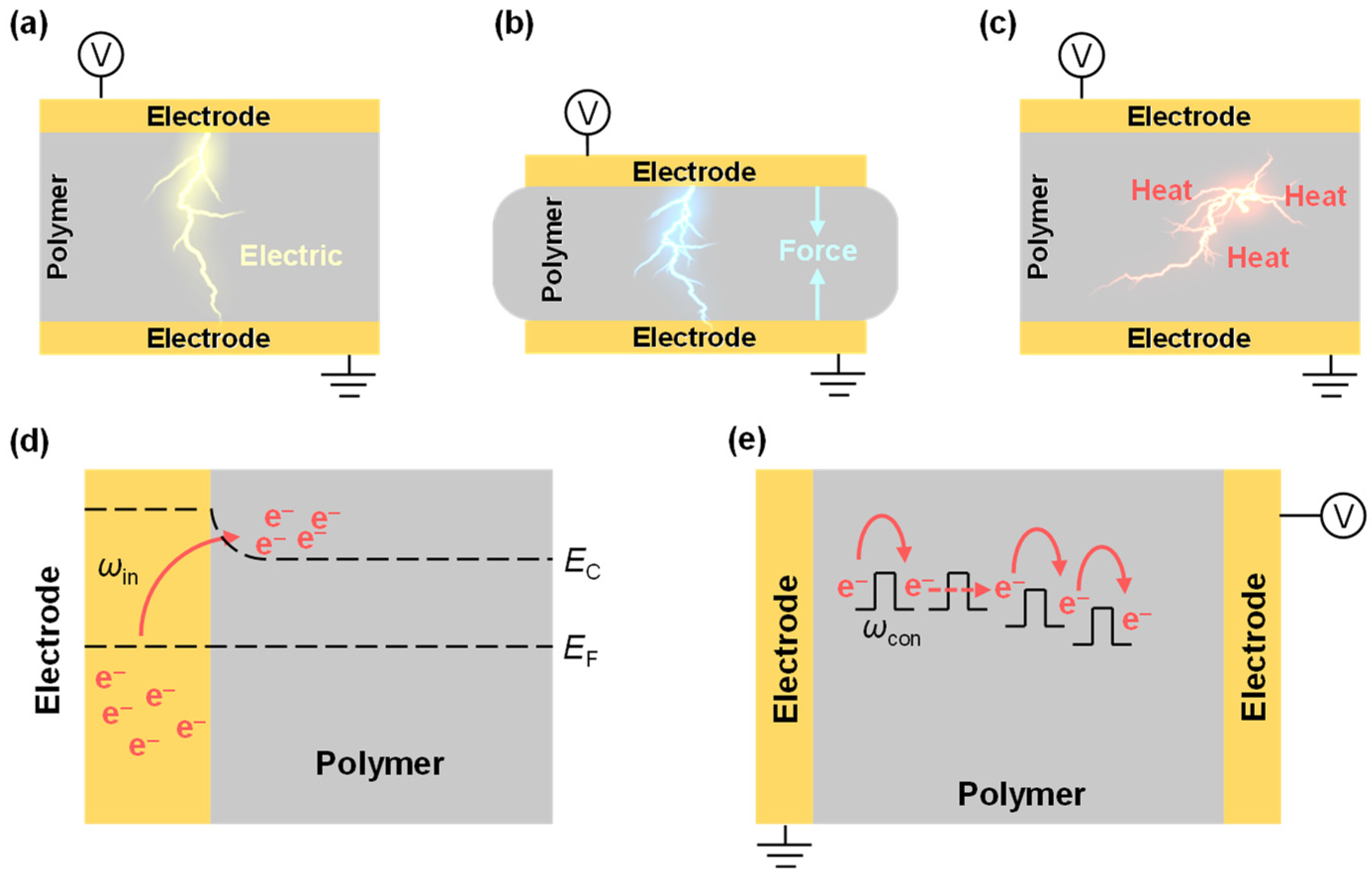
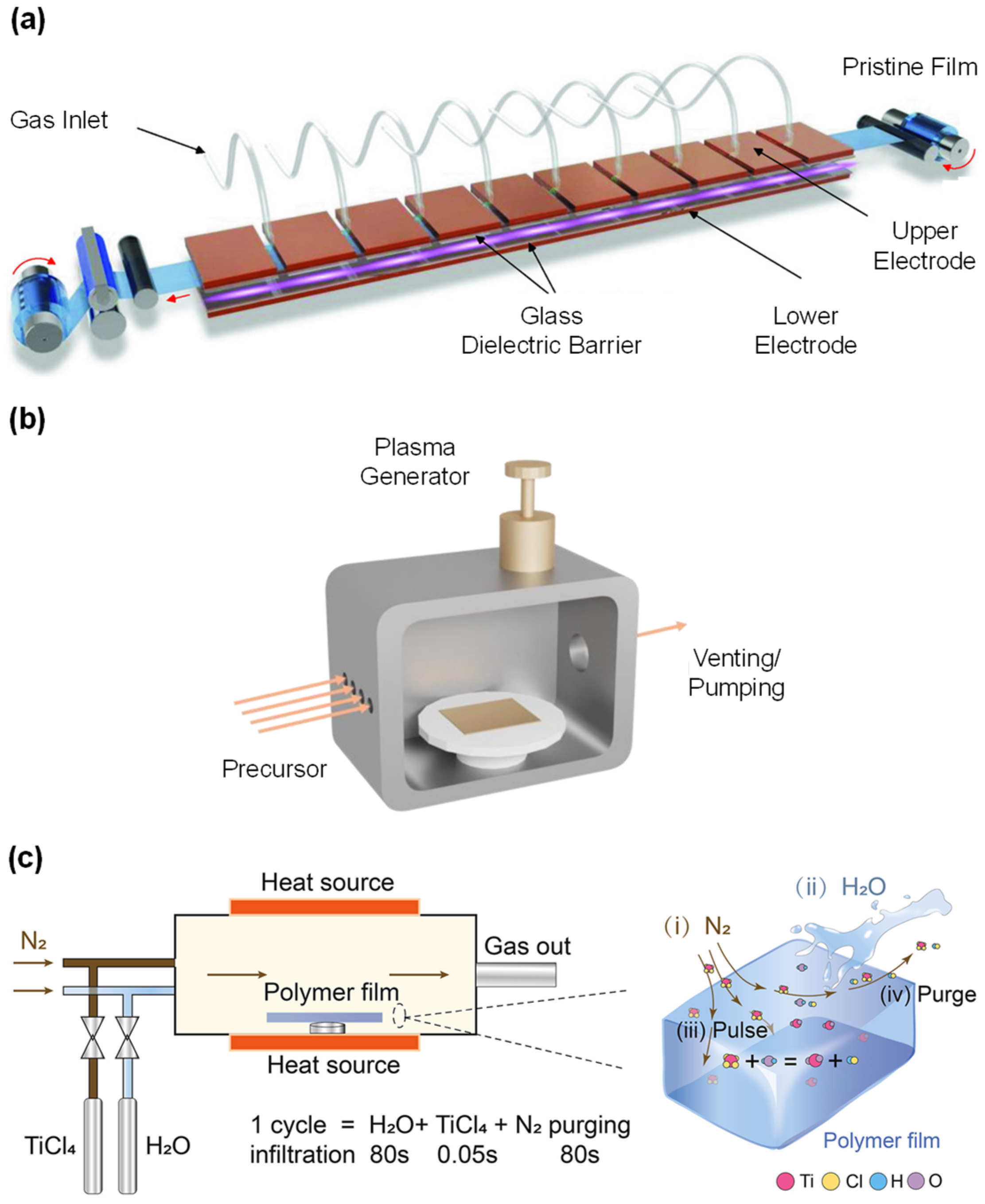
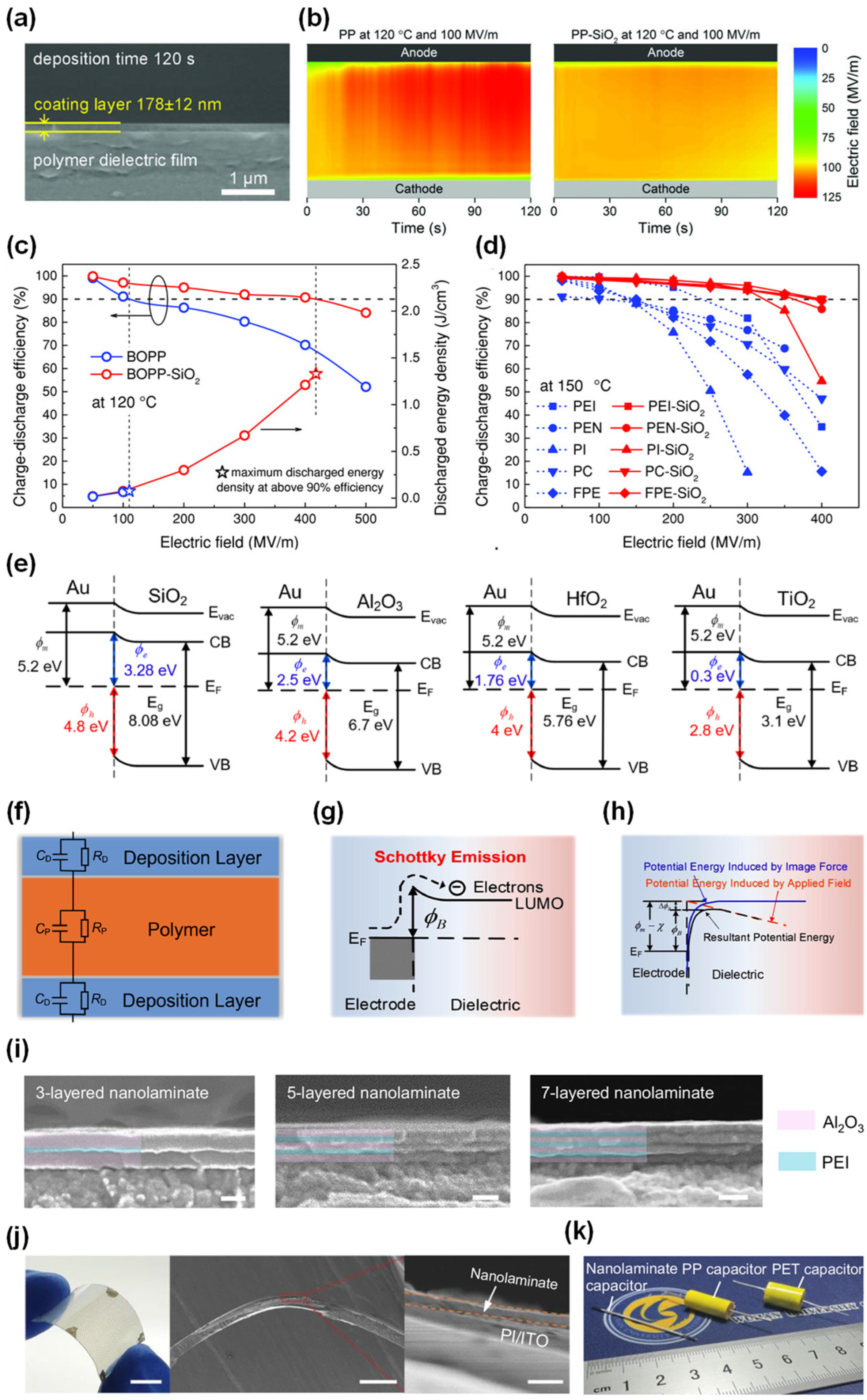

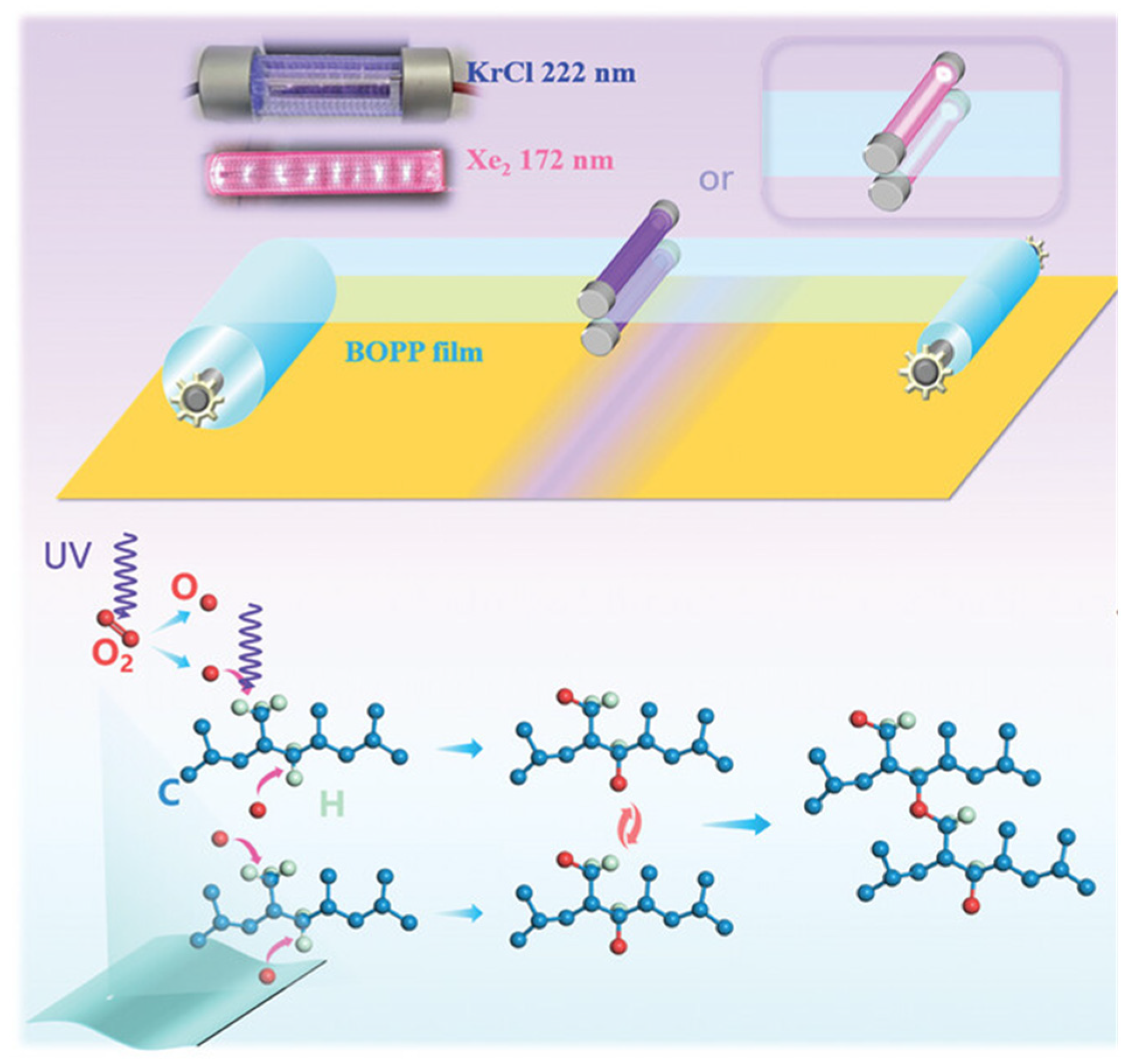
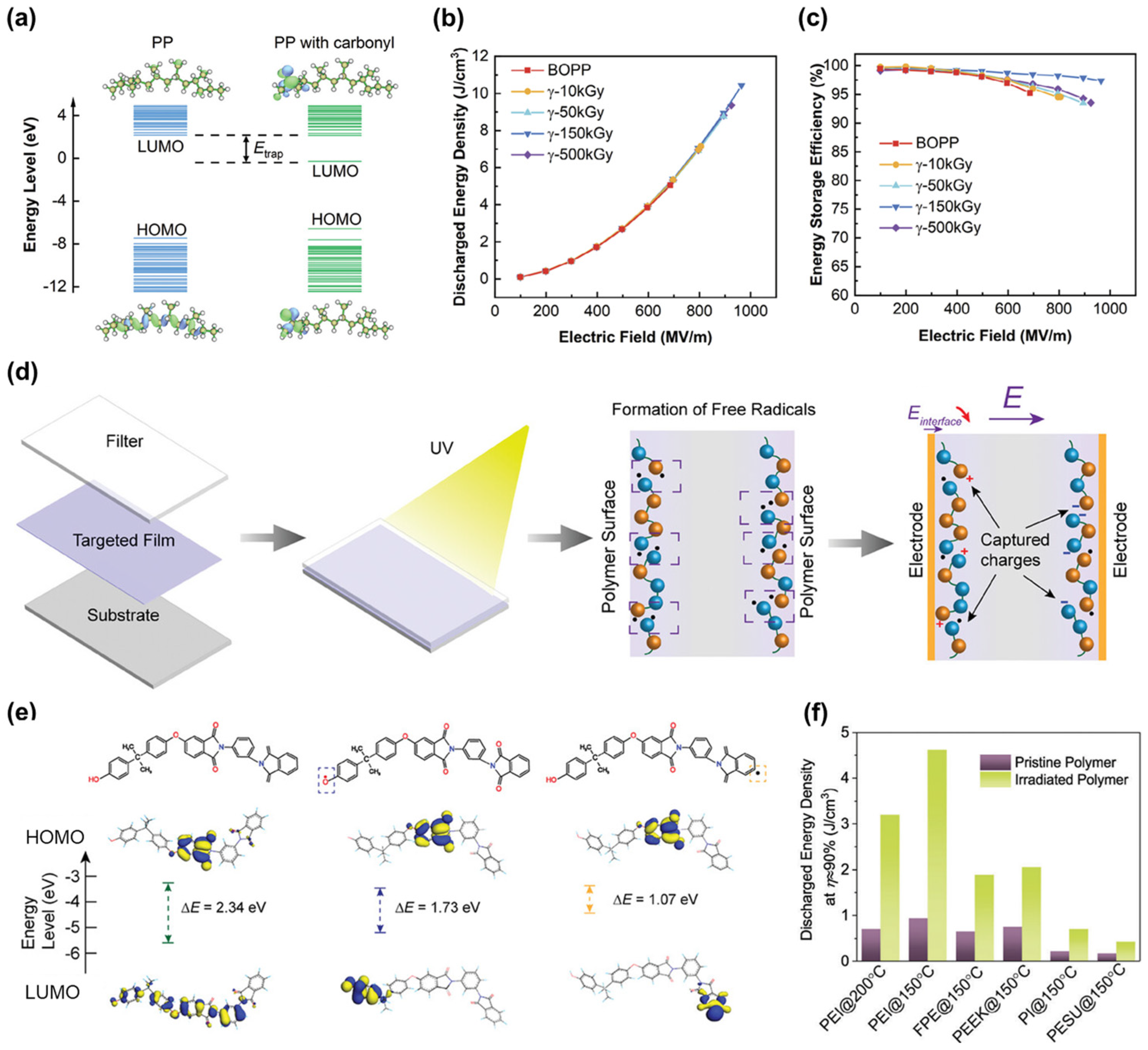
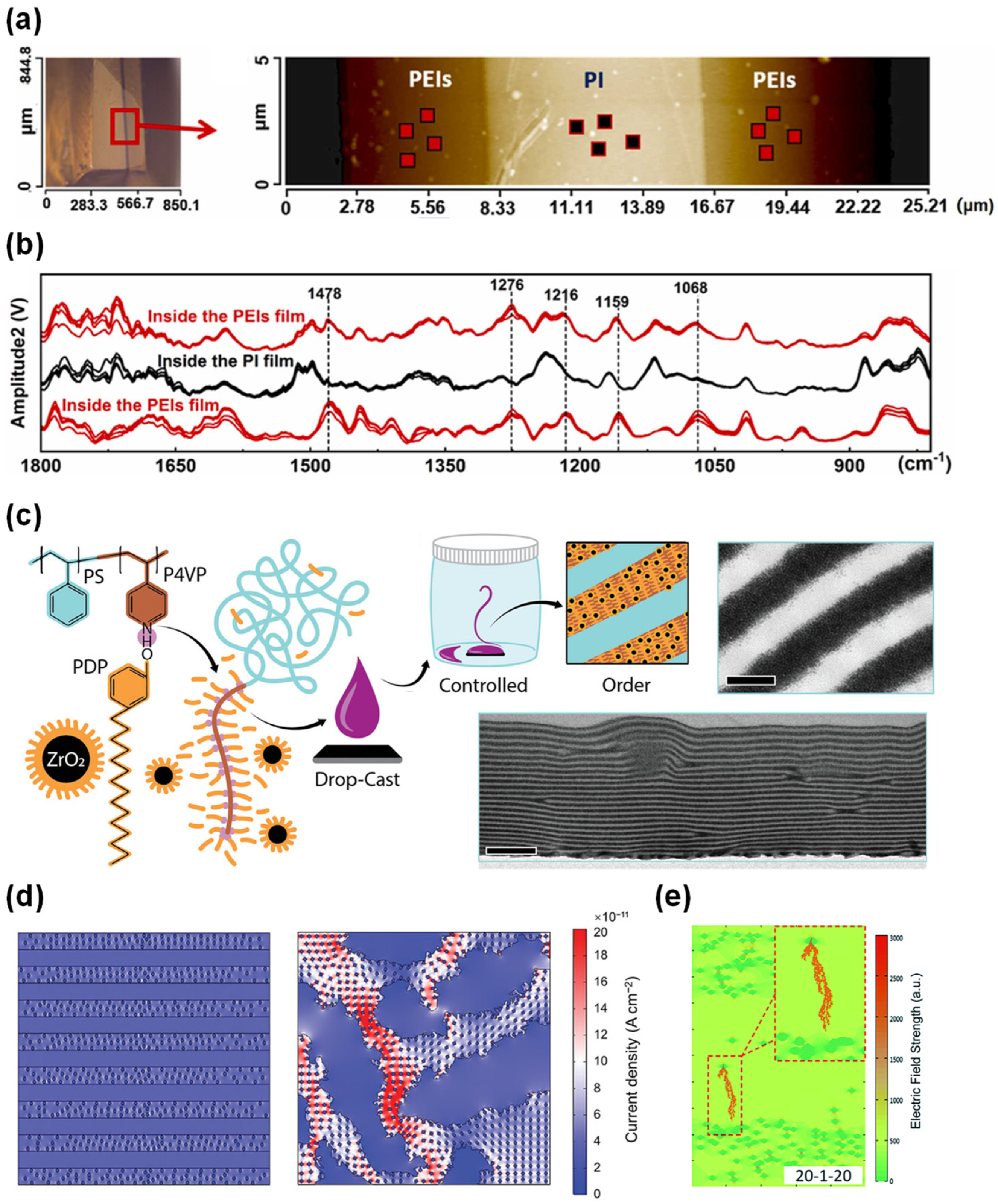
| Polymer | T (°C) | Ud-90% (J cm−3) | Ud-max (J cm−3) | Ref. |
|---|---|---|---|---|
| BOPP-SiO2 | 120 | 1.3 | 1.3 | [73] |
| PEI-150 nm Al2O3 | 150 | 3.6 | 4.0 | [76] |
| 200 | 2.8 | 3.4 | ||
| PEI/4-layer Al2O3 | RT | 8.0 | 8.0 | [79] |
| PC-BN-SiO2 | RT | 9.8 | 12.2 | [78] |
| 120 | 3.0 | 6.4 | ||
| 150 | 1.0 | 5.0 | ||
| BOPP-F | 120 | 6.2 | 8.0 | [115] |
| PI/BNNS-2 | 150 | 5.2 | 5.2 | [122] |
| 200 | 4.4 | 4.4 | ||
| Al2O3-PI-Al2O3-PI-Al2O3 | 150 | 2.3 | 3.0 | [123] |
| 200 | 1.5 | 2.2 | ||
| t-BPB-8 | RT | 7.5 | 7.5 | [124] |
| 200 | 3.7 | 4.0 | ||
| Al2O3-BT@SiO2/PI-Al2O3 | 150 | 2.3 | 3.6 | [125] |
| 200 | 1.6 | 2.6 | ||
| UV-Al2O3/PEI | 150 | 5.5 | 5.8 | [97] |
| 200 | 3.5 | 4.2 | ||
| BOPP/γ-150 kGy | RT | 10.2 | 10.2 | [96] |
| P-PEI | 150 | 4.1 | 4.7 | [99] |
| 200 | 3.1 | 3.2 | ||
| P5B4 (0.75 mg) | RT | 4.9 | 4.9 | [88] |
| 150 | 2.5 | 4.0 | ||
| bothM-LN | 150 | 2.7 | 4.3 | [89] |
| 200 | 2.0 | 4.1 | ||
| BOPP-UV-CN | RT | 11.2 | 11.2 | [85] |
| P-0.5%E | 150 | 1.8 | 1.8 | [126] |
| PS/TiO2/Al2O3 | RT | 3.7 | 4.4 | [112] |
| PEIs/PIs/PEIs | RT | 4.5 | 4.5 | [120] |
| 150 | 2.9 | 3.2 | ||
| 200 | 2.0 | 2.5 | ||
| P-1%E | RT | 3.6 | 3.6 | [127] |
| 150 | 2.2 | 2.2 | ||
| PS-b-P4VP(PDP) /9 vol% ZrO2 | RT | 6.2 | 6.2 | [62] |
Disclaimer/Publisher’s Note: The statements, opinions and data contained in all publications are solely those of the individual author(s) and contributor(s) and not of MDPI and/or the editor(s). MDPI and/or the editor(s) disclaim responsibility for any injury to people or property resulting from any ideas, methods, instructions or products referred to in the content. |
© 2024 by the authors. Licensee MDPI, Basel, Switzerland. This article is an open access article distributed under the terms and conditions of the Creative Commons Attribution (CC BY) license (https://creativecommons.org/licenses/by/4.0/).
Share and Cite
Cao, L.; Xi, R.; Zhou, C.; He, G.; Yang, F.; Xu, L.; Li, H. Polymer Capacitor Films with Nanoscale Coatings for Dielectric Energy Storage: A Review. Coatings 2024, 14, 1193. https://doi.org/10.3390/coatings14091193
Cao L, Xi R, Zhou C, He G, Yang F, Xu L, Li H. Polymer Capacitor Films with Nanoscale Coatings for Dielectric Energy Storage: A Review. Coatings. 2024; 14(9):1193. https://doi.org/10.3390/coatings14091193
Chicago/Turabian StyleCao, Liang, Rui Xi, Chen Zhou, Gaohui He, Feng Yang, Lingna Xu, and He Li. 2024. "Polymer Capacitor Films with Nanoscale Coatings for Dielectric Energy Storage: A Review" Coatings 14, no. 9: 1193. https://doi.org/10.3390/coatings14091193







